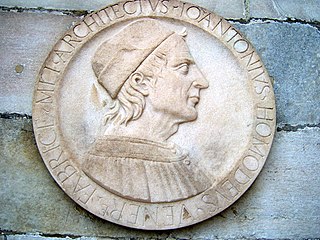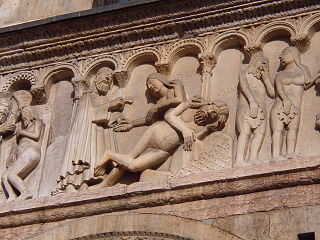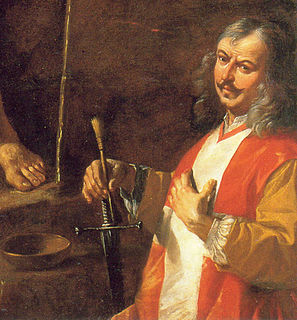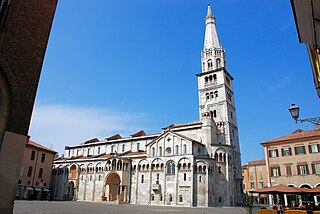
Modena is a city and comune (municipality) on the south side of the Po Valley, in the Province of Modena in the Emilia-Romagna region of northern Italy.

Grinling Gibbons was an Anglo-Dutch sculptor and wood carver known for his work in England, including Windsor Castle and Hampton Court Palace, St. Paul's Cathedral and other London churches, Petworth House and other country houses, Trinity College, Oxford, and Trinity College, Cambridge. Gibbons was born and educated in Holland of English parents, his father being a merchant. He was a member of the Drapers' Company of London. He is widely regarded as the finest wood carver working in England, and the only one whose name is widely known among the general public. Most of his work is in lime (Tilia) wood, especially decorative Baroque garlands made up of still-life elements at about life size, made to frame mirrors and decorate the walls of churches and palaces, but he also produced furniture and small relief plaques with figurative scenes. He also worked in stone, mostly for churches. By the time he was established he led a large workshop, and the extent to which his personal hand appears in later work varies.

Alessandro Tassoni was an Italian poet and writer.

Carpi is an Italian town and comune of about 71,000 inhabitants in the province of Modena, Emilia-Romagna. It is a busy centre for industrial and craft activities and for cultural and commercial exchanges.

Illusionistic ceiling painting, which includes the techniques of perspective di sotto in sù and quadratura, is the tradition in Renaissance, Baroque and Rococo art in which trompe-l'œil, perspective tools such as foreshortening, and other spatial effects are used to create the illusion of three-dimensional space on an otherwise two-dimensional or mostly flat ceiling surface above the viewer. It is frequently used to create the illusion an open sky, such as with the oculus in Andrea Mantegna's Camera degli Sposi, or the illusion of an architectural space such as the cupola, one of Andrea Pozzo's frescoes in Sant'Ignazio, Rome. Illusionistic ceiling painting belongs to the general class of illusionism in art, designed to create accurate representations of reality.
Giovanni Lanfranco was an Italian painter of the Baroque period.

Saint Geminianus was a fourth-century deacon who became Bishop of Modena. He is mentioned in the year 390, when he sent a delegate named Aper to participate in a council called by Saint Ambrose in Milan. From his name, it has been deduced that Geminianus probably belonged to the caste of Roman senators.

Giovanni Antonio Amadeo was an Italian early Renaissance sculptor, architect, and engineer.

Modena Cathedral is a Roman Catholic cathedral in Modena, Italy, dedicated to the Assumption of the Virgin Mary and Saint Geminianus. Formerly the seat of the Diocese, later Archdiocese, of Modena, it has been since 1986 the archiepiscopal seat of the Archdiocese of Modena-Nonantola. Consecrated in 1184, it is an important Romanesque building in Europe, and along with its bell tower, the Torre della Ghirlandina, is designated as a World Heritage Site.

Wiligelmo was an Italian sculptor active between c. 1099 and 1120. He was the first sculptor in Italy to produce large-format sculptures and sign his work.

Bartolomeo Schedoni was an Italian early Baroque painter from Modena.

Marcantonio Franceschini was an Italian painter of the Baroque period, active mostly in his native Bologna. He was the father and teacher of Giacomo Franceschini.

The Assumption of the Virgin is a fresco by the Italian Late Renaissance artist Antonio da Correggio decorating the dome of the Cathedral of Parma, Italy. Correggio signed the contract for the painting on November 3, 1522. It was finished in 1530.

Mattia Preti was an Italian Baroque artist who worked in Italy and Malta. He was appointed a Member of the Order of Saint John.

The Cybo, Cibo or Cibei family of Italy is an aristocratic family from Genoa of Greek origin. They came to the city in the 12th century. In 1528 the Cybos formed the 17th "Albergo", a union of noble families of Genoa. The family split in many branches, some living in Genoa, other in Naples by the name of Tomacelli. Its most famous members were Pope Boniface IX. and Pope Innocent VIII.

The Torre della Ghirlandina or simply Ghirlandina is the bell tower of the Cathedral of Modena, in Emilia-Romagna, Italy.

The Archdiocese of Modena-Nonantola is a Roman Catholic ecclesiastical territory in Italy. It existed as the Diocese of Modena in central Italy from the 4th century. Originally it was a suffragan the diocese of Milan, but later became a suffragan of Ravenna. Because of the schism of the Antipope Clement III, Pope Paschal II released Modena from obedience to the church of Ravenna, but Pope Gelasius II restored the previous status. Modena continued as a suffragan of Ravenna until 1582, when the Archdiocese of Bologna was created by Pope Sixtus V in the Bull Universi orbis of 1 December 1582, and was assigned Modena as one of its suffragans.
Giacomo Fogliano was an Italian composer, organist, harpsichordist, and music teacher of the Renaissance, active mainly in Modena in northern Italy. He was a composer of frottole, the popular vocal form ancestral to the madrigal, and later in his career he also wrote madrigals themselves. He also wrote some sacred music and a few instrumental compositions.

Madonna and Child with Saint George is an oil on panel painting by Correggio dating to around 1530 and now in the Gemäldegalerie in Dresden.
















